文章目录
- BPSK
- QPSK
- BPSK&QPSK比较
- QAM
- 16-QAM vs 64-QAM vs 256-QAM
- 512 QAM vs 1024 QAM vs 2048 QAM vs 4096 QAM modulation types
- 64-QAM Mapping Process
- QAM的优势和劣势
- ASK/FSK/PSK
- ASK
- FSK
- PSK
BPSK
BPSK stands for Binary Phase Shift Keying. It is digital modulation technique.
As mentioned in the constellation diagram binary 1 and binary 0 are represented by different carrier phases each is 180 degree apart. The simplest BPSK scheme uses two phases to represent the two binary digits and is known as binary phase-shift keying. The resulting transmitted single for one bit time is
S (t) =A* cos (2pifc*t) for binary 1
S (t) =A cos (2pifct+pi) for binary 0
This is regarded as the most robust digital modulation technique and is used for long distance wireless communication. When CINR is poor base station choose BPSK modulation technique in most of the adaptive modulation technique adopted in cellular communication.
It is less immune to the interference. Typically KMOD is 1 for BPSK in the equation.
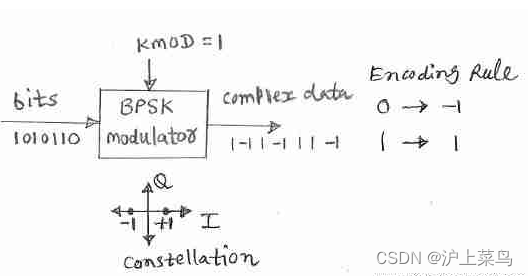
t is considered to be more robust among all the modulation types due to difference of 180 degree between two constellation points. Hence it can withstand severe amount of channel conditions or channel fading. It is used in OFDM and OFDMA to modulate the pilot subcarriers used for channel estimation and equalization. As we know different channels are used for specific data transmission in cellular systems. The channels used to transmit system related informations which are very essential are modulated using BPSK modulation.
QPSK
QPSK stands for Quadrature Phase Shift Keying. It is digital modulation technique. QPSK is bandwidth efficient as each signal point represents two bits.
For example, instead of a phase shift of 180 degree, as allowed in BPSK, a common encoding technique, known as QPSK uses phase shifts of multiples of 90 degrees i.e. pi by 2.
QPSK modulation can be represented mathematically as mentioned below.
S(t)= A* cos(2pifct + pi/4) for ‘11’ input bits
S(t)= A cos(2pifct + (3pi4)/4) for ‘01’ input bits
S(t)= A cos(2pifct -(3pi4)/4) for ‘00’ input bits
S(t)= A cos(2pifc*t -pi/4) for ‘10’ input bits
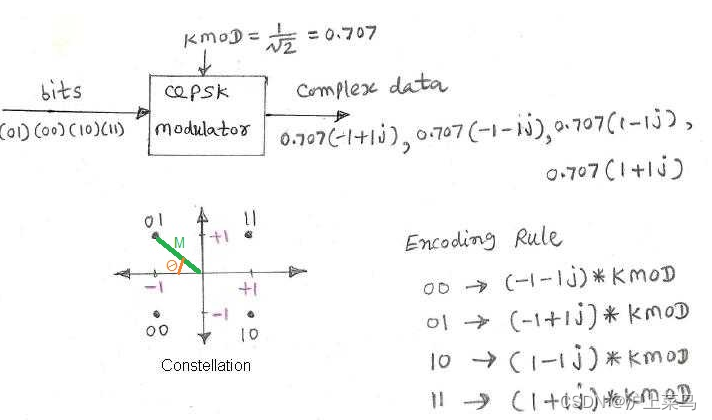
It converts two binary bits represented simultaneously at the input to the complex signal S(t) or d as mentioned. This complex signal selects one of the four phases based on two binary digits. Each state of the complex signal or waveform is called as symbol.
For QPSK, input bit stream need to break up to two-two bits and later these two bits are entered simultaneously to the input of the QPSK modulator. Hence, as shown in the constellation diagram for the input of 11 the output is (1+ j*1)KMOD, where KMOD is normalization factor. For most of the systems KMOD is 0.707
As mentioned this output of 0.707+j0.707 is called as symbol which represent two binary information digits.
BPSK&QPSK比较
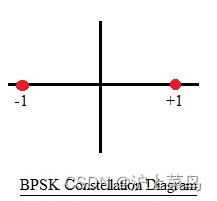
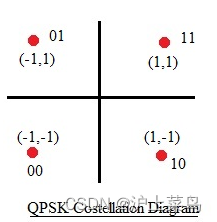


1)BPSK represents binary input 1 and 0 w.r.t. change in carrier phase by 180 degree. While QPSK represents two bits using complex carrier symbol each having 90 degree shift with one another. BPSK is considered to be robust modulation scheme compare to the QPSK as it is easy in the receiver to receiver the original bits.
2)With BPSK, higher distance coverage can be achieved from the base station cellular cell or fixed station to the mobile subscribers compare to QPSK.
3)QPSK has advantages of having double data rate compare to BPSK. This is due to support of two bits per carrier in QPSK compare to one bit per carrier in the case of BPSK.
4)BPSK is used for preamble or pilot sequences or beacon frame used for channel and other synchronization purpose. While QPSK is used for data transmission to provide higher data rate.
QAM
The full form of QAM is Quadrature Amplitude Modulation technique. It is digital modulation technique. This modulation technique is a combination of both Amplitude and phase modulation techniques. QAM is better than QPSK in terms of data carrying capacity. QAM takes benefit from the concept that two signal frequencies; one shifted by 90 degree with respect to the other can be transmitted on the same carrier. For QAM, each carrier is ASK/PSK modulated. Hence data symbols have different amplitudes and phases.
S(t)= d1(t) cos(2pifct)+ d2(t) sin(2pifct)
16-QAM vs 64-QAM vs 256-QAM
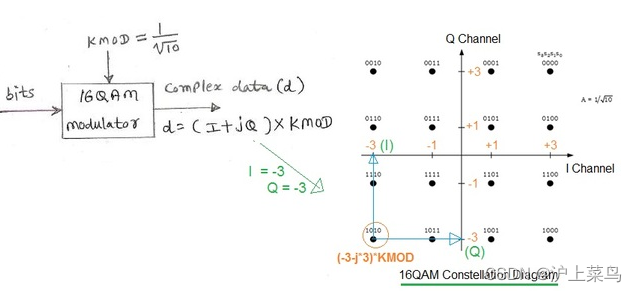

As mentioned for each symbol both phase and amplitudes are varied to represent different bits. There are two levels of amplitudes for each phase i.e. d1 level and d2 level . There are many variants to this technique. Most popular are 16-QAM, 64-QAM and 256-QAM. The example below explains 16-QAM. The 16 qam bits per symbol are 4 (four). This means in 16-QAM each symbol represents 4 bits as mentioned in the 16-QAM constellation diagram above.
For example if the input is 1010 then the output is (-3-j*3)*KMOD.
Typically KMOD is 1/root (10) for 16-QAM.
As we know in digital modulation, baseband is separated into in phase(I) and quadrature phase(Q) components. The combination of I and Q is known as baseband modulating signal. It is also referred as IQ diagram. The constellation diagram represent all the possible modulated symbols which will be used by modulation technique to map the information bits. This different symbols are represented in the complex plane with their amplitude and phase informations.
The 64 qam bits per symbol are 6 (six). In 64-QAM, each symbol is represented by 6 bits as shown in the 64-QAM constellation diagram above. In 256-QAM, each symbol is represented by 8 bits. As the level increases, QAM technique becomes more bandwidth efficient but it requires very robust algorithms in order to decode complex symbols to bits at receiver.
For example 256-QAM is complex than 16-QAM. QAM is more bandwidth efficient compare to BPSK but it is less robust. Hence for better CINR in the system QAM is employed which leads better data rate. For poor CINR, BPSK is employed. CINR stands for Carrier to Interference and Noise Ratio.
512 QAM vs 1024 QAM vs 2048 QAM vs 4096 QAM modulation types
QAM stands for Quadrature Amplitude Modulation. Each symbol in the QAM constellation represent unique amplitude and phase. Hence they can be distinguished from the other points at the receiver. Let us understand QAM modulation process at transmitter and receiver in the wireless baseband (i.e. Physical layer) chain. We will take example of 64-QAM to illustrate the concept.
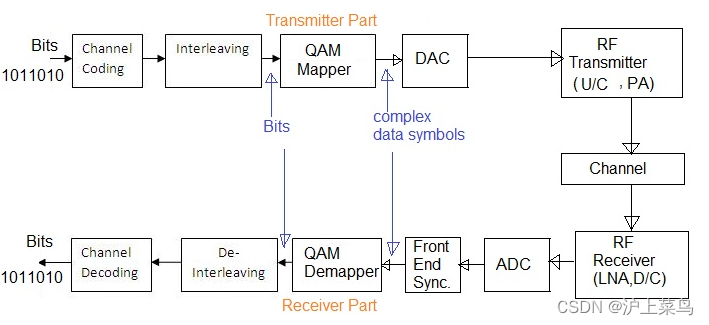
• As shown in the figure-1, 64-QAM or any other modulation is applied on the input binary bits.
• The QAM modulation converts input bits into complex symbols which represent bits by variation in amplitude/phase of the time domain waveform. The 64QAM converts 6 bits into one symbol at transmitter.
• The bits to symbols conversion take place at the transmitter while reverse (i.e. symbols to bits) take place at the receiver. At receiver, one symbol gives 6 bits as output of demapper.
• Figure depicts position of QAM mapper and QAM demapper in the baseband transmitter and receiver respectively. The demapping is done after front end synchronization i.e. after channel and other impairments are corrected from the received impaired baseband symbols.
• Data Mapping or modulation process is done before the RF upconversion (U/C) in the transmitter and PA. Due to this, higher order modulation necessitates use of highly linear PA (Power Amplifier) at the transmit end.
64-QAM Mapping Process
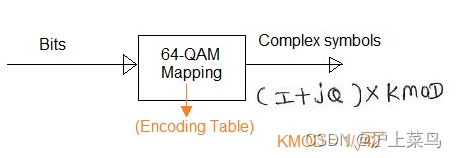
Following table mentions 64-QAM encoding rule. Check the encoding rule in the respective wireless standard. KMOD value for 64-QAM is 1/SQRT(42).
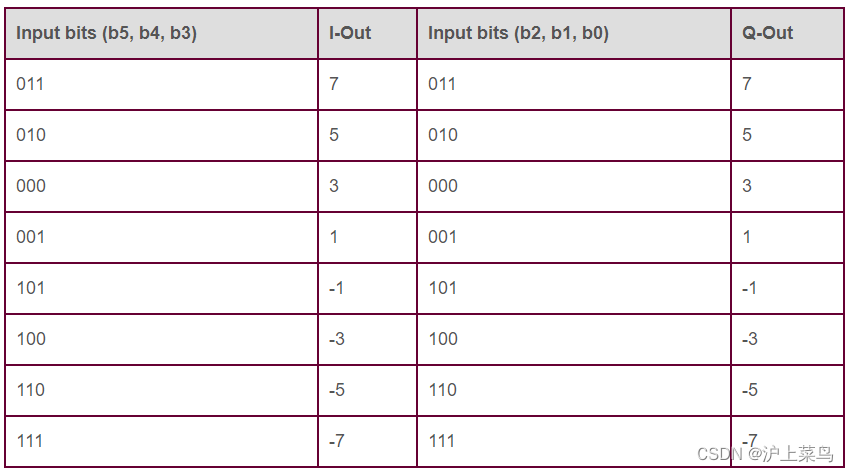
QAM mapper Input parameters : Binary Bits
QAM mapper Output parameters : complex data
The 64-QAM mapper takes binary input and generates complex data symbols as output. It uses above mentioned encoding table to do the conversion process. Before the coversion process, data is grouped into 6 bits pair. Here, (b5, b4, b3) determines the I value and (b2, b1, b0) determines the Q value.
Example: Binary Input: (b5,b4,b3,b2,b1,b0) = (011011)
Complex Output: (1/SQRT(42))* (7+j*7)
As we know in digital modulation, baseband is separated into in phase(I) and quadrature phase(Q) components. The combination of I and Q is known as baseband modulating signal. It is also referred as IQ diagram. The constellation diagram represent all the possible modulated symbols which will be used by modulation technique to map the information bits. This different symbols are represented in the complex plane with their amplitude and phase informations. The figures below depict 512 QAM constellation diagram and 1024 QAM constellation diagram.
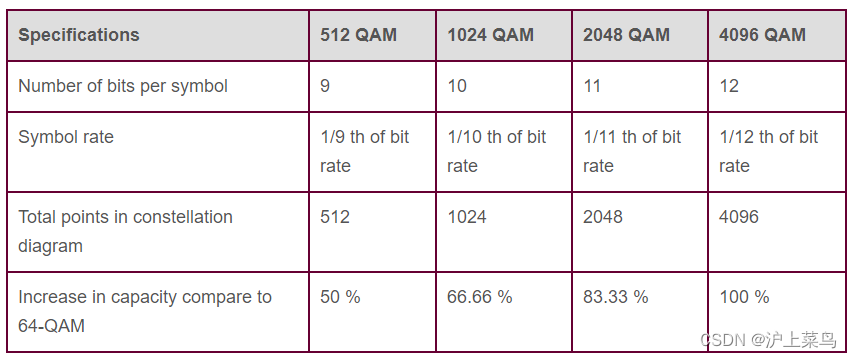
QAM的优势和劣势
Following are the advantages of QAM modulation:
• Helps achieve high data rate as more number of bits are carried by one carrier. Due to this it has become popular in modern wireless communication system such as WiMAX, LTE, LTE-Advanced etc. It is also used in latest WLAN technologies such as 802.11n 802.11 ac, 802.11 ad etc.
Following are the disadvantages of QAM modulation:
• Though data rate has been increased by mapping more than 1 bits on single carrier, it requires high SNR in order to decode the bits at the receiver.
• Need higly linear PA (Power Amplifier) at the Transmitter.
• In addition to high SNR, higher modulation techniques need very robust front end algorithms (time, frequency and channel) to decode the symbols without any error.
ASK/FSK/PSK
ASK
The short form of Amplitude Shift Keying is referred as ASK. It is the digital modulation technique. In this technique, amplitude of the RF carrier is varied in accordance with baseband digital input signal. The figure depicts operation of ASK modulation. As shown in the figure, binary 1 will be represented by carrier signal with some amplitude while binary 0 will be represented by carrier of zero amplitude
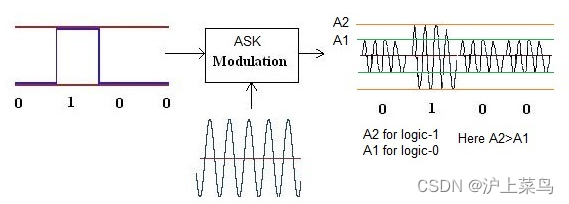
ASK modulation can be represented by following equation:
s(t) = A2* cos(2πfct) for Binary Logic-1
s(t) = A1 cos(2πfc*t) for Binary Logic-0
Here A2>A1
Signalling used is ON-OFF signalling.
Bandwidth requirement for ASK is:
BW = 2/Tb = 2*Rb
Often in ASK modulation, binary-1 is represented by carrier with amplitude-A2 and binary-0 is represented by carrier with amplitude-A1. Here A2 is greater in magnitude compare to A1. The form of ASK where in no carrier is transmitted during the transmission of logic zero is known as OOK modulation (On Off Keying modulation).
• In ASK probability of error (Pe) is high and SNR is less.
• It has lowest noise immunity against noise.
• ASK is a bandwidth efficient system but it has lower power efficiency.
FSK
The short form of Frequency Shift Keying is referred as FSK. It is also digital modulation technique. In this technique, frequency of the RF carrier is varied in accodance with baseband digital input. The figure depicts the FSK modulation. As shown, binary 1 and 0 is represented by two different carrier frequencies. Figure depicts that binary 1 is represented by high frequency ‘f1’ and binary 0 is represented by low frequency ‘f2’.
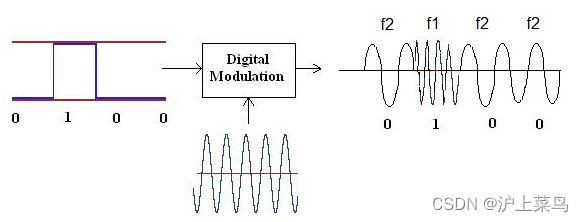
Binary FSK can be represented by following equation:
s(t) = A* cos(2πf1t) for Binary 1
s(t) = A cos(2πf2t) for Binary 0
In FSK modulation, NRZ signalling method is used. Bandwidth requirement in case of FSK is:
BW = 2Rb + (f1-f2)
• In case of FSK, Pe is less and SNR is high.
• This technique is widely employed in modem design and development.
• It has increased immunity to noise but requires larger bandwidth compare to other modulation types.
In order to overcome drawbacks of BFSK (Two level Binary FSK) , multiple FSK modulation techniques with more than two frequencies have been developed. In MFSK (Multiple FSK), more than one bits are represented by each signal elements.
PSK
The short form of Phase Shift Keying is referred as PSK. It is digital modulation technique where in phase of the RF carrier is changed based on digital input. Figure depicts Binary Phase Shift Keying modulation type of PSK. As shown in the figure, Binary 1 is represented by 180 degree phase of the carrier and binary 0 is represented by 0 degree phase of the RF carrier.
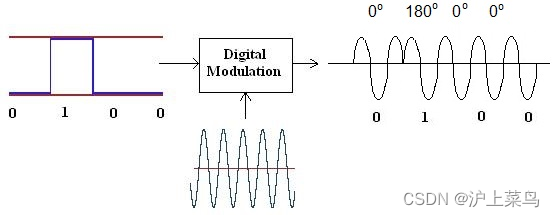
Binary PSK can be represented by following equation :
If s(t) = Acos(2πfct) for Binary 1 than
s(t) = Acos(2πfct + π) for Binary 0
In PSK modulation, NRZ signalling is used. Bandwidth requirement for PSK is:
BW = 2 * Rb = 2 * Bit rate
• In case of PSK probability of error is less. SNR is high.
• It is a power efficient system but it has lower bandwidth efficiency.
• PSK modulation is widely used in wireless transmission.
• The variants of basic PSK and ASK modulations are QAM, 16-QAM, 64-QAM and so on.
最后
以上就是奋斗蜜蜂最近收集整理的关于数字调制BPSK/QPSK/QAM/ASK/FSK/PSKBPSKQPSKBPSK&QPSK比较QAMASK/FSK/PSK的全部内容,更多相关数字调制BPSK/QPSK/QAM/ASK/FSK/PSKBPSKQPSKBPSK&QPSK比较QAMASK/FSK/PSK内容请搜索靠谱客的其他文章。








发表评论 取消回复